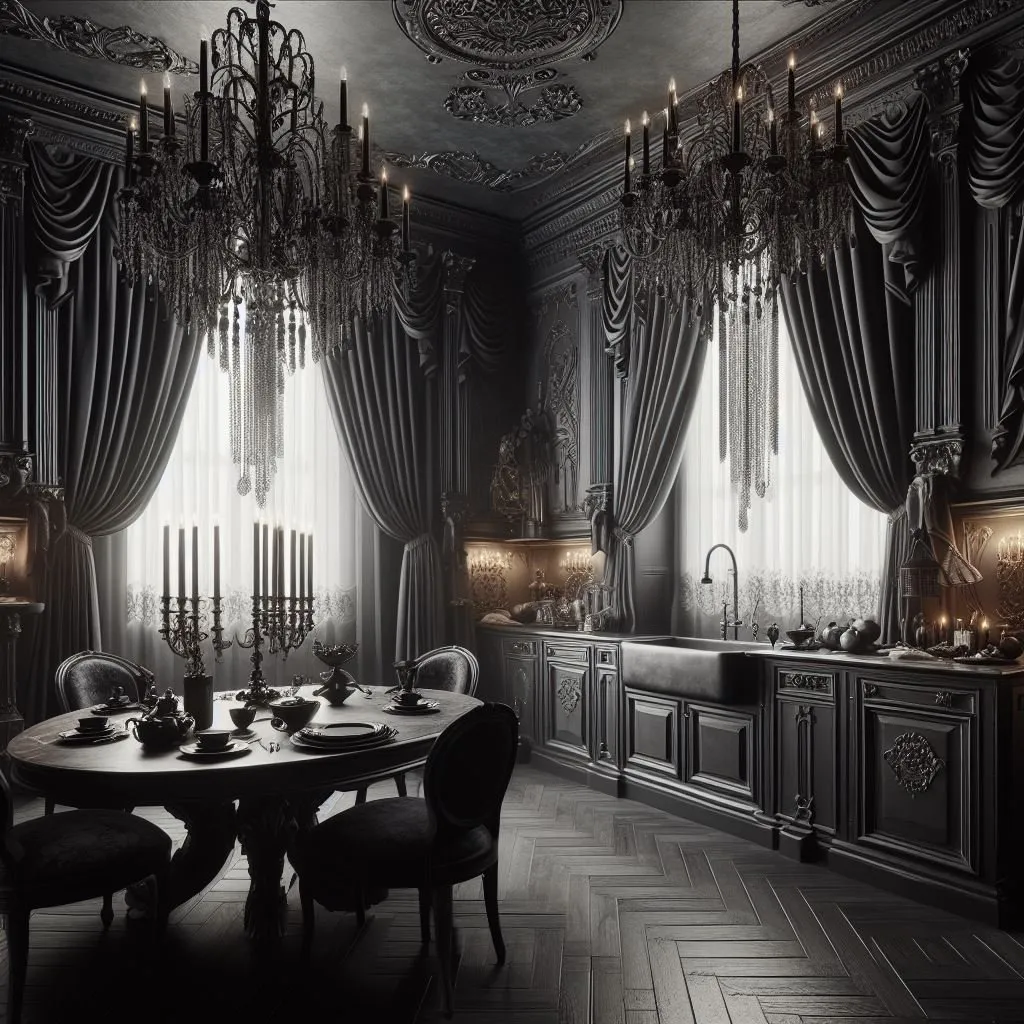Transforming your kitchen into a gothic sanctuary is an exciting endeavor. It’s about embracing a unique aesthetic that blends historical elegance with a touch of the mysterious. This style is characterized by its dramatic flair, rich textures, and the use of dark, opulent elements. This guide will provide you with essential tips and insights into incorporating gothic kitchen decor, ensuring that your space is both inspiring and functional. From understanding the core principles of gothic design to integrating the beauty of damask patterns, we’ll explore how to create a kitchen that is a true reflection of your distinctive taste. Get ready to delve into the realm of gothic kitchen decor and discover how to create a space that is both visually stunning and deeply personal.
Understanding Gothic Kitchen Decor
Gothic kitchen decor is more than just a design style; it’s a statement. It evokes a sense of history, drama, and sophistication. It takes cues from the architecture and design of the Gothic period, which flourished from the 12th to the 16th century. This style emphasizes grandeur, intricate details, and a connection to a rich cultural heritage. By understanding the core elements, you can start to transform your kitchen, layer by layer, creating a look that captures this unique aesthetic. The beauty of gothic design lies in its ability to create a space that feels both luxurious and inviting, a testament to its enduring appeal and adaptable style.
The Essence of Gothic Design
The essence of Gothic design lies in its distinctive characteristics. This style prominently features pointed arches, ribbed vaults, and stained glass. Gothic interiors often have a feeling of height and grandeur, which is achieved through the use of tall windows and soaring ceilings. The focus on intricate detailing, such as carved woodwork and ornate metalwork, is a defining feature of this aesthetic. Gothic design is inherently dramatic. The juxtaposition of light and shadow, achieved through careful lighting choices and the use of dark, rich colors, creates an atmosphere of mystery and elegance. It’s a design that invites you to step back in time, offering a sense of awe and wonder.
Key Elements of Gothic Decor
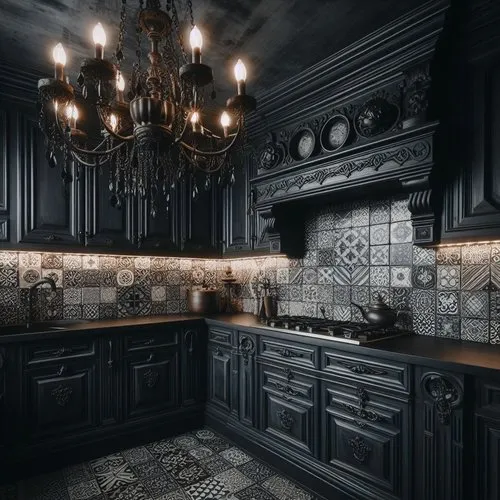
When incorporating Gothic elements, consider the materials and details. Dark wood finishes, such as mahogany or walnut, are ideal for cabinetry and furniture. Stone and brick also play crucial roles, adding texture and a sense of permanence to the space. The use of wrought iron accents, from lighting fixtures to decorative hardware, adds an authentic touch. Look for intricate carvings, such as fleur-de-lis or other historical motifs, to further enhance the look. Stained glass windows, if possible, can introduce beautiful colors and patterns. These elements combine to create the distinctive style, bringing the historical era into the modern kitchen.
Incorporating Damask into Gothic Kitchens
Damask patterns are a perfect addition to Gothic kitchens, introducing a layer of sophistication. Damask is a reversible patterned fabric, often woven with silk or other luxurious materials. Its ornate designs, characterized by detailed floral or geometric motifs, work well with the overall aesthetic of the Gothic style. Choosing damask brings both a sense of history and a touch of luxury to the kitchen. It is a highly versatile design element that can be implemented on fabrics, wallpapers or even on kitchen accessories to enhance the room. Understanding the various damask styles will help you determine how to incorporate this classic pattern in your kitchen.
Damask Patterns and Styles
Damask patterns come in a wide range of styles, from delicate floral designs to bold geometric shapes. Floral damask patterns, with their intricate depictions of roses, lilies, and other flowers, are very popular. They are often associated with traditional Gothic decor. The geometric variations, which feature repeating patterns, can add a more contemporary touch, while still adhering to the Gothic theme. Consider the scale of the pattern when choosing your damask. Large, bold patterns make a statement, while smaller, more delicate designs can provide a subtle touch of elegance. The selection of damask will significantly affect the final look. It is important to ensure the pattern reflects the overall aesthetic you want to achieve in your kitchen.
Choosing Damask Fabrics and Materials
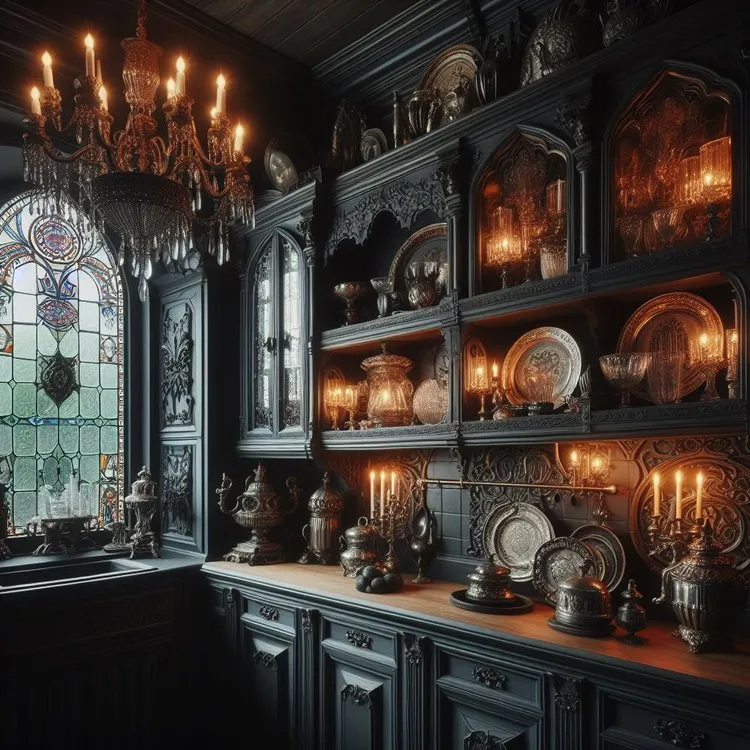
When selecting damask fabrics and materials for your kitchen, consider durability and practicality. Kitchens are high-traffic areas, so choose fabrics that can withstand wear and tear. Silk damask can be exquisite, but it may not be the best choice for high-use areas. Instead, consider damask made from blends of cotton, linen, or synthetic fibers, which offer a good balance of beauty and resilience. Think about the use of the damask. Will it be used for curtains, upholstery, or as a wall covering? Each application will require a different type of material. Also, consider the color and pattern. Dark damask patterns in deep reds, purples, or blacks can work well with the Gothic theme, creating a dramatic effect. Test swatches of fabric in your kitchen to see how the light affects the appearance.
Damask in Kitchen Decor: Practical Tips
Use damask sparingly to maintain the Gothic balance in your kitchen. A few strategically placed damask accents can enhance the style without overpowering the space. Here are some practical applications. Use damask fabric for window curtains. This allows you to add a touch of elegance and privacy. Damask upholstery on dining chairs or a breakfast nook bench can instantly elevate the space. Choose damask wallpaper for a feature wall. This adds a dramatic backdrop. Damask tablecloths or runners can bring elegance to the dining area. Consider damask tea towels or oven mitts, which will offer both functionality and style. Remember that less is often more. Careful placement and thoughtful selection of damask can create the desired impact.
Gothic Kitchen Decor Tips to Inspire
Creating a gothic kitchen involves several key elements that blend to create a stunning aesthetic. This will help you create a space that is both inspiring and functional. The combination of the right elements is key to the Gothic experience. The use of colors, architectural details, hardware and lighting creates the perfect gothic kitchen.
Dark and Moody Color Palettes
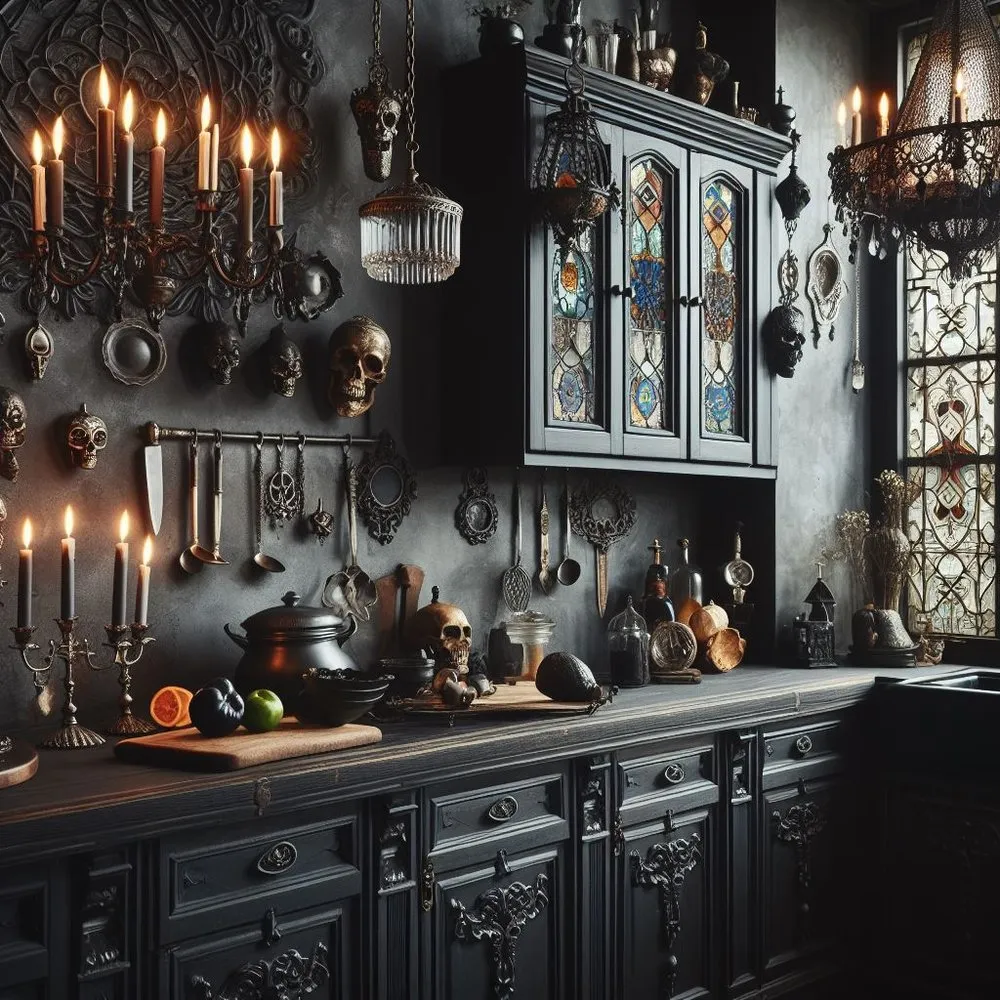
Embrace a dark and moody color palette to establish the gothic vibe. Deep hues like black, charcoal gray, and burgundy, create a sense of drama and sophistication. These colors can serve as the backdrop. You can use them for cabinetry, walls, and even appliances. Enhance the look with accent colors, such as deep greens, purples, or gold. These colors provide contrast and depth. When using dark colors, ensure adequate lighting. This prevents the space from feeling too closed-in. Consider using lighter shades for ceilings and trim. This can brighten the room. A balance of light and dark is essential. This creates a visually interesting space that captures the essence of the gothic style.
Embracing Ornate Hardware and Fixtures
Ornate hardware and fixtures are crucial for adding authenticity to your gothic kitchen. Look for cabinet pulls, knobs, and faucets with intricate detailing and dark finishes. Cast iron or wrought iron hardware is a perfect choice. These materials align with the Gothic design. Consider fixtures with an antique or vintage look. They will enhance the historical ambiance. Light fixtures are also important. Chandeliers with crystal accents can add a touch of elegance. Sconces with dark, decorative detailing are ideal for lighting. The details should add to the elegance of the room. Careful selection of hardware and fixtures will enhance the authenticity and aesthetics of your gothic kitchen, capturing its essence.
Using Gothic Furniture
Selecting the right furniture is also a key part. Gothic-inspired furniture is characterized by its strong lines, dark finishes, and intricate carvings. A dining table with a carved pedestal base or a sideboard with ornate detailing can serve as focal points. Consider using chairs with high backs, upholstered in rich fabrics like velvet or leather. Look for furniture with a sense of history and craftsmanship. Antique pieces, or pieces that have a vintage look, can add a touch of authenticity. Incorporating gothic furniture can transform your kitchen, bringing the right style and creating a space that is both functional and visually stunning, reflecting the essence of the Gothic style.
Adding Architectural Details
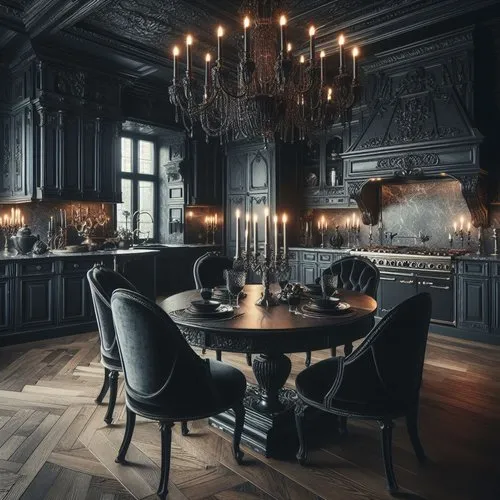
Enhance your kitchen’s architectural details for an authentic gothic touch. Add pointed arches above doorways or windows to create a gothic feel. Install crown molding with ornate detailing and add texture to the walls by using wainscoting or paneling. Consider incorporating a fireplace or a faux fireplace. These can serve as focal points, adding a sense of history and grandeur. If possible, add stained-glass windows or decorative panels. These will bring color and light. Even minor changes can dramatically change the room. Adding these features can capture the essence of Gothic style, creating a stunning and unique kitchen.
Lighting and Ambiance
Lighting plays a key role in setting the ambiance of your gothic kitchen. Use a combination of different light sources to create depth and drama. A chandelier with intricate detailing and dark finishes can be a great choice for the center of the room. Consider installing sconces with decorative shades to provide task lighting. Add accent lighting, such as dimmable track lighting, to highlight architectural details. Place candles and lanterns to add a warm, inviting glow. Ensure that the lighting is both functional and aesthetically pleasing. The right lighting will highlight the beauty of the design, setting the mood, and creating an atmosphere that is both elegant and mysterious.
Accessories and Finishing Touches
Accessories are essential for completing the look of your gothic kitchen. These small details add personality and style. Think about incorporating gothic-inspired cookware and utensils. Displaying artwork or collectibles can add a personal touch. These elements together will complete the Gothic feel of your kitchen.
Selecting Gothic-Inspired Cookware and Utensils
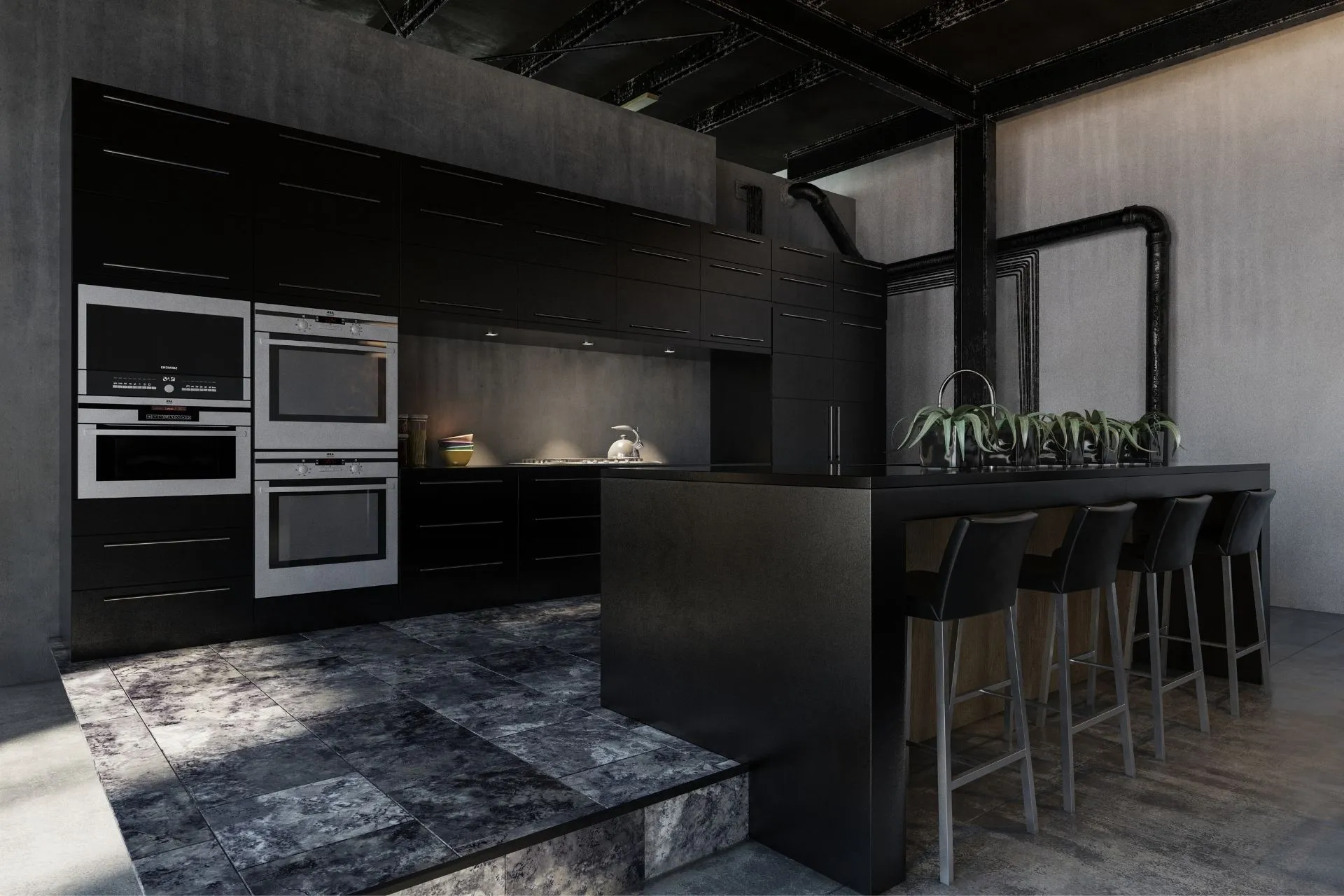
Choose cookware and utensils that complement the gothic style. Look for items with dark finishes, such as cast iron or copper. Consider adding items with ornate detailing. You can display your cookware on a hanging rack or open shelving. This adds visual interest and a practical touch. Consider using decorative serving dishes and utensils. The small details contribute to the overall design. These finishing touches ensure that your kitchen is functional and aesthetically pleasing, perfectly capturing the essence of gothic design.
Displaying Gothic Art and Collectibles
Displaying gothic art and collectibles is a great way to personalize your kitchen. Find art pieces that reflect your personal style and enhance the gothic aesthetic. Consider using framed prints of Gothic architecture, portraits, or landscapes. These can add personality and depth to the space. Collectibles can add character and charm. Place these items on shelves or in glass-front cabinets. These items will create a focal point. The combination of artwork and collectibles will showcase your personal style. They will also enhance the beauty of your gothic kitchen, creating a space that is both inviting and reflective of your style.
Creating a Cohesive Gothic Kitchen
Creating a cohesive gothic kitchen involves understanding the basic elements of the style, from the color palette to the furniture. Remember that it’s not about recreating a historical setting. It’s about creating a modern space that reflects the essence of gothic design. When you begin, select a primary color palette and build from there. Choose the right patterns, fabrics, and finishes. Don’t be afraid to combine modern conveniences with gothic accents. The goal is to create a functional and beautiful space. Focus on the details. Choose the right lighting, accessories, and finishes. A well-designed gothic kitchen is a blend of history and modernity. It will be a space that is both inspiring and inviting, reflecting your personal style.
In conclusion, creating a gothic kitchen is an exciting and rewarding project. By following these tips, you can transform your kitchen into a space that embodies elegance, drama, and timeless style. From understanding the key elements of gothic design to incorporating damask patterns and accessories, the possibilities are endless. Embrace the dark and moody color palettes, incorporate ornate hardware and fixtures, and add architectural details. These will contribute to an authentic gothic aesthetic. Remember to focus on creating a space that reflects your style and personal taste. With careful planning and attention to detail, you can create a gothic kitchen that is both stunning and functional. It will be a space where you can express your creativity and enjoy the beauty of gothic design for years to come.
